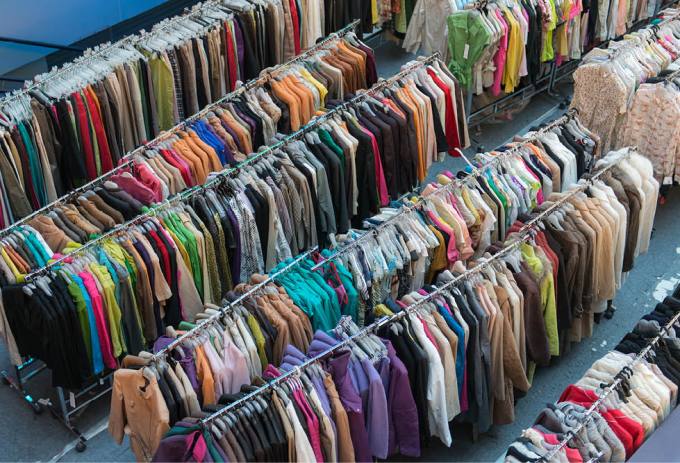Alterations at the fast fashion industry
Charlotte Nisbet, Governance and Responsible Investment Analyst, and Ama Seery, ESG analyst on the Global Sustainable Equity Team, explore the environmental damage associated with the fast fashion trade and how some companies are changing the shape of the industry.

5 minute read
Key takeaways:
- The fashion industry is one of the largest contributors to environmental damage, accounting for up to 10% of global greenhouse gas emissions.
- A number of major companies are challenging the ‘take‑make‑dispose’ model by reusing and reselling unwanted apparel. In fact, the trainer resale market has been on the rise with the market estimated to be valued at US$2bn in 2019 and US$6bn by 2025.
- Adidas and Nike have invested in developing circular business models to make their products more sustainable, with the first fully recyclable running shoe to be launched in 2021.
Recognising the issue
However, there are many exciting opportunities to invest in brands and technologies that are adapting and putting sustainability at the core of their business models. The outbreak of COVID-19 and how companies emerge from the crisis is now a focal point for investors and the fast fashion industry will have a role to play in how it adapts to tackle some of its practices to minimise the impact on the environment.
Future of retail – resale?
The fast fashion industry has created a ‘take-make-dispose’ model that is now entrenched in global societies. It is estimated that production has approximately doubled in the past 15 years, which has seen a direct correlation with the decline in usage per item of clothing. In turn, this has set the industry on a negative environmental trajectory, and could use more than 26% of the world’s carbon budget by 2050 according to the Ellen MacArthur Foundation.
The trainer resale market in particular has been on the rise. In North America, it is estimated to be valued at $2bn in 2019 and $6bn by 2025, according to investment bank Cowen & Co. Within this resale market, there is a large market for worn items. A good example of this is the site GOAT.com, a platform for selling shoes, where sellers send in trainers, which are authenticated, cleaned and then hosted on the website. There are many other second-hand platforms that have been created to support the resale market which is largely supported by millennials and Gen Z.
The resale market plays an important role in the sustainability of the apparel market as it helps to extend the life of a product. Importantly, it relies on high quality products that can withstand multiple periods of wear over a long horizon. This points to the design and production of higher quality clothes and shoes by apparel companies such as Nike and Adidas, which can provide customers and businesses with an attractive opportunity to resell products rather than see them as disposable items, which adds to the wastage issues we see today in the industry.
Creating a circular business model
Many companies have risen to the challenge and pioneered change in their business models to try and make their products more sustainable.
As part of the Global Sustainable Equity Strategy’s environmental, social and governance (ESG) analysis, we look at the life cycle of a company’s product and how they look to employ a circular economy model. Within our ‘Quality of Life’ theme we currently invest in sporting goods and apparel companies Adidas and Nike, two of the most popular resale brands. The garments they produce encourage people to lead healthy and active lifestyles, an essential part of human health and wellbeing. We believe the high-quality product design and patented technologies produced by Adidas and Nike are key drivers of the high brand equity and customer loyalty. These companies have invested in research and development (R&D) and technology to create more circular business models. We continually engage with these companies to understand how they plan to invest in creating more sustainable products and how they are working towards reaching their ambitious sustainability targets, which will be increasingly important as manufacturing restarts once the global lockdown eases.

Adidas has been working to increase the use of more sustainable materials in its production and products while driving towards ‘closed‑loop’ solutions. The company announced that from 2024 onwards it would use only recycled polyester in every product and on every application where a solution exists. Futurecraft Loop, the first fully recyclable running shoe, is due to be launched in 2021.
Nike, has similarly been working on creating a more circular business model with many of its core products using upcycled (reused) materials. All the core polyester yarn for the Flyknit shoes are 100% recycled polyester and Nike has diverted more than 4 billion plastic bottles from landfills by using recycled polyester. Sustainability is not a new trend for Nike; Nike Grind was launched in 1992, where surplus manufacturing materials and athletic footwear are taken and used to create new footwear and apparel, as well as sports surfaces.
A collective responsibility
As consumers, we can be responsible by showing retailers that we want sustainably made clothes and shoes, and as investors, we can be responsible by picking the best in class stocks, which put circular business models at the heart of their business models and innovate to create a more sustainable retail environment.
1 Ellen MacArthur Foundation, A new textiles economy: Redesigning fashion’s future, (2017, http://www.ellenmacarthurfoundation.org/publications).
2 UNEP ‘Fashion’s tiny hidden secret’ (2019, https://www.unenvironment.org/news-and-stories/story/fashions-tiny-hidden-secret).
3 BCG and Global Fashion Agenda, ‘Pulse of Fashion Industry’, 2017, https://globalfashionagenda.com/wp-content/uploads/2017/05/Pulse-of-the-Fashion-Industry_2017.pdf
4 Boston Publishing Group and Global Fashion Agenda. “Pulse of the Fashion Industry.” 2017.
These are the views of the author at the time of publication and may differ from the views of other individuals/teams at Janus Henderson Investors. References made to individual securities do not constitute a recommendation to buy, sell or hold any security, investment strategy or market sector, and should not be assumed to be profitable. Janus Henderson Investors, its affiliated advisor, or its employees, may have a position in the securities mentioned.
Past performance does not predict future returns. The value of an investment and the income from it can fall as well as rise and you may not get back the amount originally invested.
The information in this article does not qualify as an investment recommendation.
Marketing Communication.
